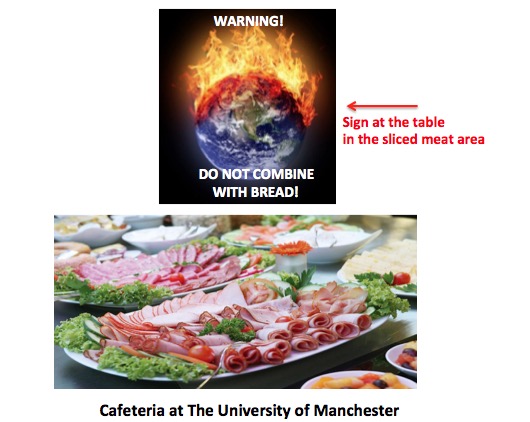 |
| Member of the British Sandwich Association Photo: Twitter |
The following was written with a straight face. I swear.
"Do you take a packed lunch to work or buy a sandwich from the shop? The carbon footprint of your sandwich could be having a major impact on greenhouse gas emissions according to new research. EurekAlert! January 24, 2018So was this:
"Researchers at The University of Manchester have carried out the first-ever study looking at the carbon footprint of sandwiches, both home-made and pre-packaged."Yes. It real. And here's the paper that was referred to in the EurekAlert!
"Understanding the impact on climate change of convenience food: Carbon footprint of sandwiches."
Journal of Sustainable Production and Consumption https://doi.org/10.1016/j.spc.2017.12.002
Don't you find it astounding that this was the first study of its kind? I just don't get it. How did science possibly miss out on this until now? What else was missed? You're gonna tell me that these studies haven't been done either?
- "The impact of annual horseradish consumption in Cleveland on the photo-magnetic spectrum of the Aurora Borealis on Arbor Day: A meta-analysis."
- "How to talk to your potholders."
- "Deuterated Cheeze-Whiz. A novel MRI contrast agent."
- "Treatment of MRSA infections of the pinky toe with counterfeit Louis Vuitton bags filled with rotting mackerel heads: A Randomized, Double-Blind, Placebo-Controlled Study."

Back to the paper. First, you better believe that there will be some pretty severe anti-sandwich restrictions in the cafeteria at the University of Manchester. These guys mean business!

The paper is very long and full of details. Some are worth examining.
 |
Some of these include:
- Egg and cress sandwiches are the 3rd most popular sandwich in the UK.
 |
| It would appear that this young woman doesn't much care for egg&cress sandwiches. |
- "A total of 16 variations on 55 the recipe for ham and cheese sandwich were considered" (55 recipes for ham and cheese sandwiches??? Wonder what the average age of the first myocardial infarction is in that household)
- The materials required to make a store-bought sandwich are equivalent to 1.205 homemade sandwiches. (In case anyone asks you)
- "Overall, the highest carbon footprints (< 1200 g CO2 eq.) are for the sandwiches with a combination of pork meat (bacon, ham or sausages), cheese and prawns." (Good thing people don't eat pigs feet sandwiches. They already have a footprint. Four per pig)
- "The carbon footprint of home-made sandwiches ranges between 399 and 843 g CO2 eq./sandwich. The results are largely proportional to the amount of ingredients used — the lightest sandwich weighs 99 g and has the lowest carbon footprint of 399 g CO2 eq. while the heaviest sandwich weighs 190 g and has the highest carbon footprint of 843 g CO2 eq." (The lesson? Light sandwiches weigh less than heavy sandwiches.)
- "An alternative approach to reducing the carbon footprint of sandwiches (and the energy content) would be to reduce the amount of key ingredients such as meat, cheese and eggs."
Finally, there's this:
- Excluding tomato and lettuce lowers the carbon footprint by 3.3%–8.9%
- Not using mayonnaise yields a further reduction of 1.7%–8.4%. 21
- Similar reductions can be achieved by reducing the amount of food waste in the supply chain (3.1%–8.5%) and by adopting waste management options other than landfilling, combined with changes in sandwich packaging (2.5%–9.5%).
- Substituting white bread with wholemeal bread achieves a very limited reduction in the carbon footprint (<0 .1="" li="">
- Thus, combining these improvement opportunities could reduce the carbon footprint of commercial sandwiches by up to 50%
Speaking of which, here are my footprints getting away from this stupid article as quickly as possible.
Bon Appétit!
NOTE:
(1) Turns out it was the 4th Earl of Sandwich who gave it the name. How the first three got the name of something that wasn't invented yet beats the hell out of me. I'd look it up, but I gotta run over to Subway. Sudden urge.
No comments:
Post a Comment